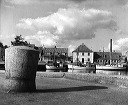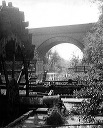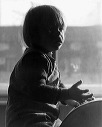timeline
Early Days
I must have learned something about photography from my Dad, who was in the photographic trade and had been a photographer before and – in the RAF – during WW2. I didn't have any training as such, from him or anyone else, but there were cameras around the house and I guess it wasn't too difficult to work out what to do with the chemicals. Recently I discovered a few prints that I'd produced in my teens (a long time ago) ... Click the images for technical details and extended captions.
The first three, original size 10 x 8in, were my first ever exhibition entries (click to open a larger image). Looking at them after all these years I think they're not too bad. In the middle two I've put something in the foreground to give a feeling of depth – I still try to do that now with landscapes. No-one had told me about the 'Division of Thirds' or the 'Golden Mean', but the one on the left seems to have got it about right. Classic composition...
What someone had told me was: "use a yellow-green filter" [for monochrome, of course]. These days people often use red or orange, for a really dramatic sky, or nothing at all. Which is a pity, because the yellow-green helps the sky and lightens foliage without overdoing it. At that time I was using a Rolleiflex dating from about 1929, which my Dad bought before the war, and the prints were mounted on the then obligatory cream-coloured textured board.
Taken a short while later, the fourth image was one of a series on mills in Northamptonshire, visited by bicycle. The main thing I remember about the print – which at 12 x 10in was my biggest print to date, and seemed huge – is that there's an awful scratch across the centre of the neg and I spent hours trying to retouch it!
timeline
Starting Again
In the early 1970s, after a break of a few years, I decided to try to get back into photography in a more serious way and I joined my local photographic club, Hertford & District Camera Club, in the hope that I might learn something. After all these years I'm still a member. And have I learnt anything? Well, you'll have to be the judge of that as you wander through this site, which I hope you will.
The club is not a teaching organization. In common with most other clubs it survives on a diet of talks, competitions and occasional practical evenings. It provides an environment in which to discuss photography, and an incentive to produce and show new work. People learn by discussing their photography with others, and by listening to the comments of judges on other people's pictures as well as their own. At least, that's how it's been for me.
Most of the visiting lecturers and judges are volunteers, of course. They do it because they enjoy looking at pictures, and because they want to give out their knowledge and experience to others. Many of them are experienced and knowledgeable photographers: most of them amateurs at a high level, some of them professionals. For me they've been the key to giving my photography some sort of direction. Later I learned to disagree with them, but this in itself is a very creative stimulus because you have to work out the reason why, not just feel hurt that they didn't like the picture!
I'm pleased to have been the only President [in 1976] – and probably the only member in the club's 60 year history – to have scored zero in a competition: no-one ever gets less than 5 out of 10! The print was technically quite OK, but it upset the judge, a photographer for whom I had great respect, so much that she gave it zero marks. I felt I'd achieved something!
But all this came a bit later, after I'd learned about colour printing [see 3rd and 4th images above] and really belongs in The Seventies. Before that I had a little run-in with a judge (who shall remain nameless) who did not always achieve the highest standards of the judge's craft. I was in the Beginners section, and it was only my second or third print competition...
The tale of the
“Picture Suitable for a Charity Poster”
In those days, two competitions each year were 'Set Subject'. In other words we had to shoot pictures relating in some way to a specific subject (like pros do every day). The benefit is that it makes you think about the photos rather than rummaging though the holiday snaps and hoping to find a good one. The disadvantages are that whoever thinks up the subject has to pick a good one; it must not be too challenging or people won't bother to enter, but it must not be too broad or it will be too easy. But most important, the judge has to be switched on, prepared and capable of judging the thing sensibly.
My two entries were the 1st and 2nd images above. The first is called Let Me Explain – we didn't have to be specific about our charity, but I had in mind a children's or handicapped charity. The second, an old lady's face superimposed (in the darkroom) on an image of a Victorian teacup containing carefully placed tealeaves, is called Her Fortune Depends On You. But the judge didn't understand. I didn't mind that, though I'd worked quite hard on the prints. But it was clear he didn't understand the competition at all – near the end of the evening he uttered the immortal line: "Help the Aged, isn't that some sort of charity?" And from that moment I've been happy to ignore the comments of any judge who seems to be living on a different planet.
You are here: Home > Photography > timeline » Early Days : top







